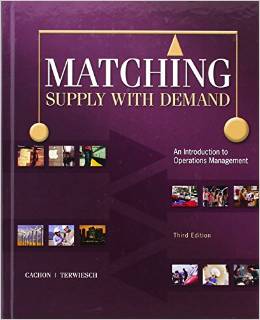Test Bank for Matching Supply with Demand An Introduction to Operations Management 3rd Edition Gerard Cachon ( Only Final Exam)
$35.00 Original price was: $35.00.$26.50Current price is: $26.50.
Test Bank for Matching Supply with Demand An Introduction to Operations Management 3rd Edition Gerard Cachon ( Only Final Exam)
This is completed downloadable of Test Bank for Matching Supply with Demand An Introduction to Operations Management 3rd Edition Gerard Cachon ( Only Final Exam)

Product Details:
- ISBN-10 : 0073525200
- ISBN-13 : 978-0073525204
- Author: Gerard Cachon (Author), Christian Terwiesch (Author)
Gerard Cachon and Christian Terwiesch, Matching Supply with Demand: An Introduction to Operations Management, 3e is the most authoritative, cutting-edge book for operations management MBAs. The book demands rigorous analysis on the part of students without requiring consistent use of sophisticated mathematical modeling to perform it. When the use of quantitative tools or formal modeling is indicated, it is only to perform the necessary analysis needed to inform and support a practical business solution.
The guiding principle in the development of Matching Supply with Demand has been “real operations, real solutions.” “Real operations” means that most of the chapters in this book are written from the perspective of a specific company so that the material in this text will come to life by discussing it in a real-world context. “Real solutions” means that equations and models do not merely provide students with mathematical gymnastics for the sake of an intellectual exercise.
Table of Content:
WEMBA 631
Operations Management: Quality and Productivity
FINAL EXAM
Name ____________________________ __________________
Instructions
The exam consists of 32 total questions, with Basic questions, and more challenging Advanced questions identified by an (*) at the end. Reasonable performance on the Basic questions is sufficient to pass this exam, but we encourage you to attempt the advanced questions, as time permits.
The exam is open/ open notes and you may use a calculator. We will give points for correct answers, but will not subtract points for incorrect answers, so you should answer all questions.
In order to make your calculations as straightforward as possible, assume that, unless stated otherwise,
- there are sufficient parts or raw materials so that the initial operation(s) are never starved;
- processing times have negligible variability, and over time, workers neither speed up nor slow down, but work always at the processing rates given;
- there are no machine breakdowns;
- when there are buffers shown, they are large enough to accommodate any amount of inventory that would reside in those buffers under normal operations;
- travel time and time to transport parts from one operation to the next is negligible;
- all operations run with 100% yield, i.e., the operations produce no defective units; and
- all processes are in steady state (e.g., in the middle of the day); thus, you may ignore any start-up effects.
| Exam Score | Course Grade | ||
|
One Hour Loan
One Hour Loan offers customized loans. Customers call a toll free number with a specific loan request, and obtain a response within an hour. One Hour Loan’s business process includes five activities which must be conducted in the sequence described below. (The time required for each activity is shown in parenthesis):
Activity 1: Answer customer call and record key information. (4 minutes)
Activity 2: Gather and format the information (obtain credit scores, organize customer specific needs) for analysis (5 minutes)
Activity 3: Analyze the information: Check the credit worthiness, and decide loan amount and APR to offer. (7 minutes)
Activity 4: Perform final checks on loan offer (2 minutes)
Activity 5: Call customer back with the new loan offer and close. (4 minutes)
The whole process is conducted by three workers in a worker paced line. The assignment of tasks to workers is the following:
W1 does Activity 1.
W2 does Activities 2 and 3.
W3 does Activities 4 and 5.
- What is the bottleneck of the process?
- How much time will it take to process 100 loans? (Assume that the process starts with an empty production line)
- What is the utilization of worker 3? (You can assume that the process operates at capacity and you do not have to consider any empty system effects)
- What is the average labor utilization of the workers? Assume the process operates at its capacity and there are no empty system effects.
- What are the direct labor costs for one loan application? Assume a wage rate of $20 per hour.
To increase the production rate, One Hour Loan is considering two alternatives:
Alternative I: To hire a new worker to help any one (and only one) of the workers without changing the tasks performed by each worker.
Alternative II: To redesign the assignment of tasks to workers. For this, the company is evaluating to re-assign Step 2 from W2 to W1.
- Suppose that Alternative I is chosen. Which worker should the new employee assist?
- What would be the costs of direct labor of one loan application under the solution depicted above? Assume there is sufficient demand (system operates at its capacity) and there are no empty system effects.
- What would be the direct labor costs for Alternative II?
|
Comfy Shoes Inc
Comfy Shoes Inc builds shoes tailored to meet each individual customer’s needs. Customers who visit the downtown offices of Comfy Shoes in Philadelphia can choose one or more of the following four custom-tailoring services. Customers receive their shoes in the mail within a week of their initial visit.
| Service | Description | Time | Resource used |
| A. Walking Basics | Take measurements for basic walking shoes. | 12 min. | 1 attendant |
| B. Walking Plus | Choose specific design (e.g. material, color selection) | 12 min. | 1 attendant |
| C. Running Basics | Take measurements for tailor-made running shoes | 10 min. | 1 attendant |
| D. Running Adv | Consult physical therapist and obtain precise needs for running shoes. Also choose specific design. | 40 min. | 1 attendant |
The company offers the following packages to their customers:
- Package 1: Includes only Walking Basics (Service A)
- Package 2: Includes Walking Basics and Walking Plus (Services A and B).
- Package 3: Walking Basics, Walking Plus and Running Basics (Services A, B and C).
- Package 4: All four services (A, B, C, and D)
Customers of Comfy Shoes visit the store at a constant rate (you can ignore any effects of variability) of 20 customers per day. Of these customers, 45% buy Package 1, 10% buy Package 2, 20% buy Package 3 and 25% buy Package 4. The mix does not change over the course of the day. The store operates 12 hours a day.
- What is the implied utilization of the attendant in service D?
- Which resource has the highest implied utilization?
At the end of the spring season, Comfy Shoes anticipates an increase in the demand to 50 customers per day. A change in the mix of packages demanded is also expected: 30% of the customers ask for Package 1, 10% for Package 2, 10% for Package 3 and 50% for Package 4. The company will hire an additional attendant to help with Service A (Walking Basics)
- What will be the bottleneck in the process given this new demand pattern?
- How many customers a day will not be served? *
People Also Search:
matching supply with demand an introduction to operations management 3rd edition
matching supply with demand an introduction to operations management
matching supply with demand an introduction to operations management 3rd edition testbank download pdf
matching supply with demand an introduction to operations management 3rd edition download scribd
Related products
Test Bank
Test Bank for Essentials of Business Law and the Legal Environment, 11th Edition: Richard A. Mann
Test Bank
Test Bank for Operating Systems: Internals and Design Principles, 7th Edition: William Stallings











